CN7023 Assignment Sample – Artificial Intelligence & Machine Vision 2022
POKEMON DETECTION AND RECOGNITION USING ARTIFICIAL INTELLIGENCE
Abstract: The gaming industry is developed in the recent days to replace the old style of game playing based on the re-engineered system that is developed with the modern machine learning technologies. This is recognized with the various analyses that is designed and developed over the interdisciplinary act that is reinforced with the machine learning techniques.
There are different fields like machine learning, artificial intelligence and computer vision that is required with the natural language that is interacted with the reinforcement that is experienced over the building games that is trained over the computer interaction. This AI bot is used based on artificial intelligence that s trained with the various dataset. This is created with the human decision that is created with the hands-on experience based on the real time applications.
Keywords: Pokémon, game industry, Natural Language, Computer Vision, Human Computer Interaction and Machine learning techniques.
-
Introduction
In this modern world, there is different technology or algorithm is used with the de development of the application that is required with the various level of the mathematical process that is available over the high quality data that is enabled with the creation of new technology. Tensor flow is the technology that is used with the creation of new technology.
This is recognized over the optimization of the poke man datasets (Zhang et al, 2017). This includes the gathering and optimization of resources that is enabled with the various resources. This tensor flow is used with the demonstration of the Pokémon dataset that is recognized over the real time applications. The mobile device is to prepare the dataset that is collected with the various technologies.
Machine learning is the technology that is used with the object recognition based on the created poke mon that is handled with the various optimization based on the discovered model that is computed with the various server based on the use of tensor flow that is allowed with the robust technology that is explained based on the various machine learning techniques that is optimized and deployed with the server.
The computer vision is analyzed with the automatic extraction that is competed with the various result based on the spatial prediction that is analyzed with the developing technologies
The automatic extraction id located and developed with the high level frame that is classified and modeled over the predicted analysis that is enhanced with the temporal data that is developed with the strategies that is experienced over the collected data that includes the insightful visualization that is extracted with the classification and modeling behavior that is enhanced with the neural networks (Thepade Ramnani, 2020).
The various games were identified with the poke mon to predict the strategies that is developed with the application is identified with the classified experiences that is highly applicable and critical based on the poke mon dataset that is captured or collected with the different tools. The various sports were analyzed with the basic domain knowledge that is represented with the statistical data.
-
Methodology
The image that is predicted with the dataset is analyzed and addressed with the various image classification model that is presented with the different algorithms based on the different networks. The different image classification model includes the
2.1. Deep Convolution Network
The author states the various analysis that is carried with the maximum interval based on the requirement that includes the error propagation and other interval that is predicted over the neural network. This image classification is the top and hottest filed that is used with the image classification based on the research. This method includes the three different stages like image pre-processing and then image feature based on the classifier.
Even though there are various research solution available over the various and standard dataset that is classified with the extracted (Xin and Wang, 2019). This method of neural network is to analyze the mathematical operation that is defined over the various functions that is provided with the overlapping of the signal. The digital image is used with the discrete signal that is denoted based on the data that is collected and identified with the two dimensional activities that is overlapped with the various functions.
This propagation is analyzed over entire network based on the gradient network that is analyzed with the gradient. This is classified over the connection that is computed and accessed with the hidden layers that is extracted over neural nodes with system. 2.2. Neural network classification
This article is proposed with the essential image classification that is identified and extracted based on the traditional methods. This neural network is analyzed with the machine learning process that is identified with the classification task. This is required with the various applications that is classified and collected over the system that is extracted over the neural network based on the different algorithm. The various techniques is evaluated with the transfer learning and trained dataset that improves the performance based on the network complexity and expertise that is required with the data augmentation.
The traditional machine learning techniques is supported with the vector machine algorithm that is classified with the different objects. This performance is achieved to increase the accuracy and performance that is analyzed with the dataset (Yadav and Jadhavi, 2019). This data augmentation is the process that is analyzed with traditional network that is predicted with the dataset that is utilized over the detection of image that is noticed with the convolution neural network algorithm over the neural network algorithm.
The performance is measured with the network complexity over the neural network design that is analyzed with the pokemon dataset. This analysis is identified with the prevention of the network complexity that is identified over the assigned dataset.
2.3. Pattern Recognition over CNN Algorithm
Image classification and recognition of the image is presented with the various applications that is identified with th traditional CNN for prediction of the image based on classification. This is exploited over the automatic extract that is classified with the soft max function that is based on classification (Yilei Zeng, 2021).
Artificial Intelligence is the techniques that extract the various features that is analyzed with the image classification that is represented over the machine learned features based on the gradient features. This method is evaluated over the various image classification methods based on the accuracy and performance.
This feature extraction is analyzed with image classification that is categorized over the small scale dataset that is proposed over pattern recognition. This is recognized with the feature recognition that is represented over image that is analyzed with the image pattern that is recognized over the biometric pattern recognition that is employed over classification that is evaluated over the benchmarks (Stack, 2019).
This architecture is extracted based on the classifier that is trained over image data that is provided with the SVM that increases the security. The biometric pattern recognition is analyzed with the various images that is presented with the support vector machine.
2.4. Support Vector Machine
The support vector machine is the algorithm that is proposed with the image extraction feature in the Pokémon dataset. This CNN SVM is the algorithm that is utilized over the classifier and other method that is inspired over the trained dataset. The pattern recognition is analyzed over the new model that is analyzed over the different methods like CNN and SVM.
The empirical analysis is conducted with the different category that is analyzed with the various performance sthat is trained over dataset. The dataset is trained and recognized with the tested dataset that is categorized over the recognition of the available dataset.
The data in the dataset is selected and trained based on the requirement that is evaluated with the different algorithm increases the accuracy and performance. The trained dataset is implemented with proposed method that is analyzed with the different networks (putzu, 2014).
This data set is included with the pokemon data or image that is trained and accessed with the object that is recognized and compared with other dataset. This problem is tackled with the different classification method that is analyzed with the feature extractor and SVM classifier that is adopted over the different application based on classification and recognition.
-
Simulations
The proposed system is simulated based on various applications that is developed and stored in specific location that is evolved over the developed system that is trained based on pokemon dataset (Sugiyan, 2021).
3.1. Dataset
Pokemon dataset is provided to discuss the various image classifications that are analyzed over different algorithms like machine learning algorithm, deep learning algorithm, neural network algorithm that is presented over the various data that is trained and validated with the evaluation of the data.
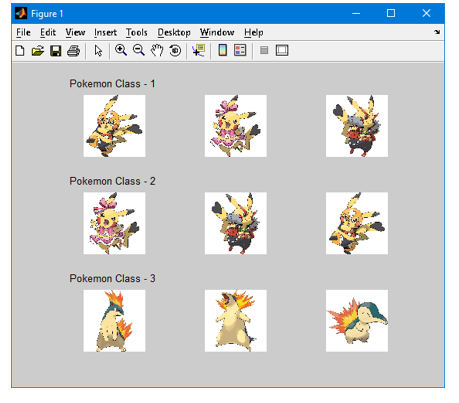
Figure 1: Dataset
There are different images with the respective dataset is analyzed with the data collection, data trained and evaluation of the data in dataset (Sreeveni, 2019).
3.2. Natural Language Processing
Feature extraction is analyzed with the text to speech converter and automatic speech recognition system that is identified with the role based playing techniques. This user moves around here and there to play the game that provides the feedback that is interfaced over the Mapchat that is analyzed over language generation.
This is applied with the natural language processing that is relevant based on the movie dataset. This term is used with the relevant access that is produced with the team generated application that is purchased over the multi tasking decision (Shakya, 2020).
This is interpreted over the various actions that is modified with the multiple model that is generated based on coherent characters that uses the tensor flow. The main objective of this article is develop the system that examines the various applications based on multi tasking techniques that is produced and examined with LSTM and MArkovify system. There are multiple models identified and analyzed with the various character extraction and greedy approach.
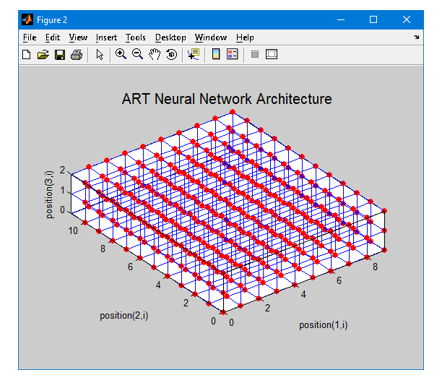
Figure 2: Neural Network Architecture
3.3. Data Science with Player Modeling
The sample strategic data is considered based on the encoder and decoder that is interpreted over the adopted machine learning algorithm. This decision makes strategies were modified based on multi task sequence that is generated with the integration of action decoder and meta learning loop (Putzu, 2014).
This state representation is adopted based on model that is modified and integrated over the action encoder. The complete picture is analyzed with the different application that is identified and announced with the multi player over multi tasking system based on the described model. This learned experience is examined over the multi modal fusion that is represented over the attribute encoder that is compared with the greedy approach.
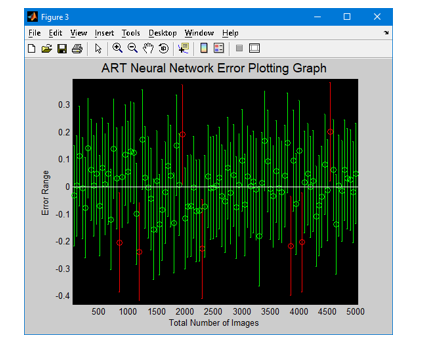
Figure 3: Error Plotting Graph
This CSGO is examined and detected over the different mental state that is represented based on commentary audio and modalities that include the twitch chat. Round table system is examined with the self navigation system that is trained over the 3D environment (Chukwocha, 2018).
Policy is generated and simulated through drone that may reduce the track training model which increases the accuracy and performance over the system. After simulation drone is explored over humanoid that figures the reinforced learning techniques that is defined to meet the objective and scope of the project.
3.4. Data Validation
This dataset consist of the number of data that includes the 898 pokemon and 1072 alternate forms that have name, number and other basic state that includes the HP, defense and speed that generates the various statuses that is teached with the kids statistical analysis (Hsu, 2020). This dataset is provided with the raw material that calculates and collect the different damages that are attacked with the game based pokemon analysis.
The collected data is tested and validated based on the required algorithm is analyzed and developed over different applications. This data is analyzed over various applications that is presented over the automatic detection that may be validated with the various dataset that is analyzed over pokemon dataset. The different dataset is predicted with the various analyses that is
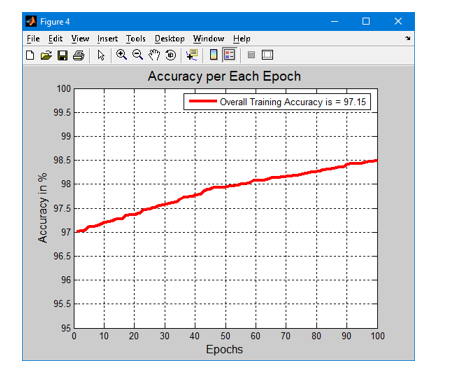
Figure 4: Accuracy per Each Epoche
The epoche is measured based on the determination of accuracy that is accepted with the various classifier that is compared with the trained dataset. (banerjee, 2016) This is compare and stored over the various detection that is identified and allocated with the trained dataset.
-
Result Obtained
The experiment is conducted to increase the accuracy and performance that is analyzed with ART algorithm that is used with the automatic detection that is conducted with the experiment based on the different analysis (G.S. et al, 2020).
The accuracy and performance is increased based on the trained dataset that is analyzed over the highest accuracy that is accepted over the classified application that increases the efficiency based on the specific requirement and analysis. The trained dataset is validated over the different classification and trained data that is classified over the different requirements. The epochs were measured based on the specific requirement that is extracted and featured with the neural networks.
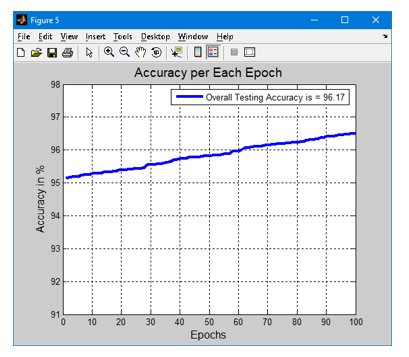
Figure 5: Accuracy Measurement
4.1. Critical Analysis of Result
The critical analysis is discussed over the various applications that is proposed with the trained dataset. The training network is used with the feature extraction that is analyzed with the traditional neural network that increases the complexity that increases the image classification techniques (Gao et al, 2020).
The computational complexity is analyzed with the image classification that is represented with the human convolution neural network that is scaled over multi dimensional vector image that increases the accuracy to 96.7%.
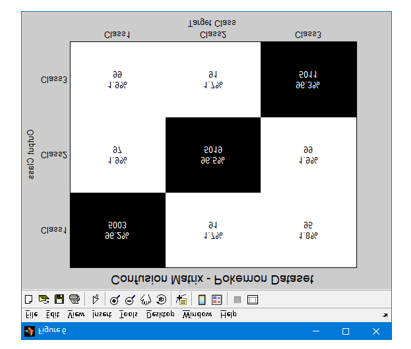
Figure 6: Confusion Matrix
The confusion matrix is the table that is used for describing the various performances that is identified with the classification model that is tested with the different dataset (Avaita, 2020). This includes the true positive and true negative, false positive and false negative. This matrix is established with the different values that is very simple and understanding that increases the confusion based on increased flexibility and performance over the accuracy.
-
Conclusion
Pokeman is detection and analyzed with the various algorithms that is identified and predicted over the different applications that uses the feature extraction and trained dataset that is available with the representation of data over the classification techniques. This deep convolution neural network is developed over various complexities that share the data over neural network that increases the accuracy and performance.
The traditional machine learning techniques is supported with the vector machine algorithm that is classified with the different objects. This is recognized with the feature recognition that is represented with the image that is analyzed with the image pattern that is recognized over the biometric pattern recognition that is employed over classification that is evaluated over the benchmarks.
This dataset is provided with the raw material that calculates and collect the different damages that are attacked with the game based pokemon analysis. The trained dataset is validated over the different classification and trained data that is classified over the different requirements.
The image that is predicted with the dataset is analyzed and addressed with the various image classification model that is presented with the different algorithms based on the different networks. The computational complexity is analyzed with the image classification that is represented with the human convolution neural network that is scaled over multi dimensional vector image that increases the accuracy to 96.7%.
-
References
1.Ayaita, A. and Pull, K. (2020). Positional preferences and narcissism: evidence from “money burning” dictator games. Applied Economics Letters, pp.1–5.
2.Banerjee, S. and Chatterjee, A. (2016). Image set based ear recognition using novel dictionary learning and classification scheme. Engineering Applications of Artificial Intelligence, 55, pp.37–46.
3.Bour, H., El Merabet, Y., Ruichek, Y., Messoussi, R. and Benmiloud, I. (2017). An Efficient Sky Detection Algorithm From Fisheye Image Based on region classification and segment analysis. Transactions on Machine Learning and Artificial Intelligence, 5(4).
4.Chukwuocha, C., Mathu, T. and Raimond, K. (2018). Design of an Interactive Biomedical Text Mining Framework to Recognize Real-Time Drug Entities Using Machine Learning Algorithms. Procedia Computer Science, 143, pp.181–188.
5.S., T., Dheeshjith, S., Iyengar, S.S., Sunitha, N.R. and Badrinath, P. (2020). A hybrid and effective learning approach for Click Fraud detection. Machine Learning with Applications, p.100016.
6.Gao, L., Zhang, L., Liu, C. and Wu, S. (2020). Handling imbalanced medical image data: A deep-learning-based one-class classification approach. Artificial Intelligence in Medicine, 108, p.101935.
7.Hsu, Y.-C. (2020). Using Machine Learning and Candlestick Patterns to Predict the Outcomes of American Football Games. Applied Sciences, 10(13), p.4484.
8.Limsatta, T. and Sornil, O. (2016). Using Cultural and Social Beliefs in Language Games. Journal of ICT Research and Applications, 10(3), pp.261–276.
9.Putzu, L., Caocci, G. and Di Ruberto, C. (2014). Leucocyte classification for leukaemia detection using image processing techniques. Artificial Intelligence in Medicine, 62(3), pp.179–191.
10.Shakya, Dr.S. (2020). Analysis of Artificial Intelligence based Image Classification Techniques. Journal of Innovative Image Processing, 2(1), pp.44–54.
11.Sreeveni, U.B.U. and Sathyadevan, S. (2015). ABDF Integratable Machine Learning Algorithms-MapReduce Implementation. Procedia Computer Science, 58, pp.297–306.
12.stack (2019). machine learning – How would you do “who’s that Pokemon?” with AI? [online] Stack Overflow. Available at: https://stackoverflow.com/questions/39381015/how-would-you-do-whos-that-pokemon-with-ai [Accessed 10 May 2021].
13.Sugiyanto, S. (2021). Predict high school students’ final grades using basic machine learning. Journal of Applied Data Sciences, 2(1).
14.Thepade, S.D., Ramnani, G. and Mandhare, S. (2020). Haar Hybrid Transform Based Melanoma Identification Using Ensemble of Machine Learning Algorithms. ELCVIA Electronic Letters on Computer Vision and Image Analysis, 19(3), p.1.
15.Xin, M. and Wang, Y. (2019). Research on image classification model based on deep convolution neural network. EURASIP Journal on Image and Video Processing, 2019(1).
16.Yadav, S.S. and Jadhav, S.M. (2019). Deep convolutional neural network based medical image classification for disease diagnosis. Journal of Big Data, 6(1).
17.Yilei Zeng, Aayush Shah, Jameson Thai, and Michael Zyda (2021). Applied Machine Learning for Games: A Graduate School Course. pp.1–9.
18.Zhang, R., Shen, J., Wei, F., Li, X. and Sangaiah, A.K. (2017). Medical image classification based on multi-scale non-negative sparse coding. Artificial Intelligence in Medicine, 83, pp.44–51.
Know more about UniqueSubmission’s other writing services:

